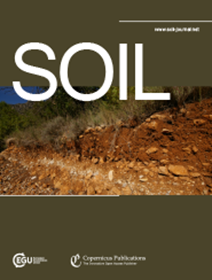农业土壤温室气体通量测量的灵活、开放设计自动化系统
IF 4.3
2区 农林科学
Q1 SOIL SCIENCE
引用次数: 0
摘要
摘要。近几十年来,由于当前的气候变化形势,人类活动对气候影响的研究变得非常重要,而农业是土壤温室气体的主要来源之一。有不同的技术来量化土壤气体通量,例如微气象技术或室内技术,最后一种技术能够评估同一地点的不同处理。手动室是最常用的技术。然而,手动室的特点是采样频率低;通常,每天一个样本被认为是高采样频率。因此,需要付出很大的努力来监测诸如施肥或再润湿等短期排放事件。因此,自动化室系统提供了改善土壤气体通量测定的机会,但由于成本和具有挑战性的技术实施,它们的分布仍然很少。本研究的目的是开发一种用于农业系统的自动化室系统,并将其与手动室系统进行比较。此外,在一个月的时间内,两个系统测定了土壤气体通量,以比较它们捕捉土壤气体排放的时间变异性的能力。与手动室系统相比,自动化系统报告的土壤温室气体(GHG)通量中CO2和N2O的通量分别高出58%和40%。此外,自动化室系统的较高采样频率使我们能够捕获每日通量变化,从而更准确地估计累积土壤气体排放。此外,对不同采样时间间隔的评估表明,为了获得具有代表性的日排放量,10:00 - 12:00 LT是土壤气体采样的最佳时间间隔。本研究强调了腔室尺寸和形状在腔室系统开发中的重要性,以及手动腔室系统的采样频率和采样时间。本文章由计算机程序翻译,如有差异,请以英文原文为准。
Measurement of greenhouse gas fluxes in agricultural soils with a flexible, open-design automated system
Abstract. Over the last decades and due to the current climate change situation, the study of the impacts of human activities on climate has reached great importance, with agriculture being one of the main sources of soil greenhouse gas. There are different techniques to quantify the soil gas fluxes, such as micrometeorological techniques or chamber techniques, with the last one being capable of assessing different treatments at the same site. Manual chambers are the most common technique. However, manual chambers are characterized by low sampling frequency; typically, one sample per day is considered to be a high sampling frequency. Therefore, a great deal of effort is required to monitor short-term emission events such as fertilization or rewetting. For this reason, automated chamber systems present an opportunity to improve soil gas flux determination, but their distribution is still scarce due to the cost and challenging technical implementation. The objective of this study was to develop an automated chamber system for agricultural systems and to compare it with a manual chamber system. Moreover, over a period of 1 month, the soil gas fluxes were determined by both systems to compare their capabilities in capturing the temporal variability of soil gas emissions. The automated system reported soil greenhouse gas (GHG) fluxes that were up to 58 % and 40 % greater for CO2 and N2O fluxes compared to the manual chamber system. Additionally, the higher sampling frequency of the automated chamber system allowed us to capture the daily flux variations, resulting in a more accurate estimation of cumulative soil gas emissions. Furthermore, the assessment of various sampling intervals for single-day measurements indicated that between 10:00 and 12:00 LT was the optimal time interval for soil gas sampling in order to obtain representative daily emissions. This study emphasizes the importance of chamber dimension and shape in the development of chamber systems, as well as the sampling frequency and sampling hour for manual chamber systems.
求助全文
通过发布文献求助,成功后即可免费获取论文全文。
去求助
来源期刊

Soil
Agricultural and Biological Sciences-Soil Science
CiteScore
10.80
自引率
2.90%
发文量
44
审稿时长
30 weeks
期刊介绍:
SOIL is an international scientific journal dedicated to the publication and discussion of high-quality research in the field of soil system sciences.
SOIL is at the interface between the atmosphere, lithosphere, hydrosphere, and biosphere. SOIL publishes scientific research that contributes to understanding the soil system and its interaction with humans and the entire Earth system. The scope of the journal includes all topics that fall within the study of soil science as a discipline, with an emphasis on studies that integrate soil science with other sciences (hydrology, agronomy, socio-economics, health sciences, atmospheric sciences, etc.).
 求助内容:
求助内容: 应助结果提醒方式:
应助结果提醒方式:


